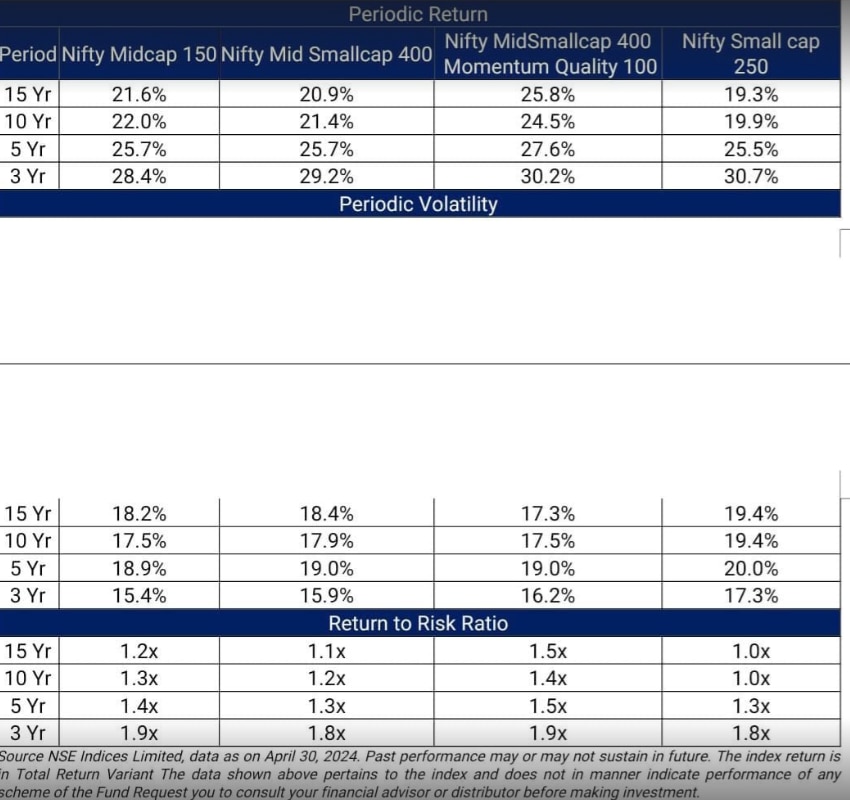In last 12 months large-cap category has witnessed outflow of Rs. 615 crore whereas mid-cap category has witnessed inflow of Rs. 22,250 crore. Interestingly, large & mid-cap category together witnessed an inflow of Rs. 22,450 crore. This data highlights that there are a lot of investors who prefer the combination of largecaps and midcaps over large-cap category for various reasons. The existence of such combination allows fund to be flexible and control their risk framework and investors seem to like categories with such flexibility like Multi Cap, Flexi Cap etc.
Similarly, drawing parallel to midcaps and smallcaps, while distinct category exists, there is no true to label mid-small-cap category in existence and given the discussion around valuation being stretched in either mid or small or both, it is indeed the need of the hour to have a fund that provides exposure to the entire mid-small-cap category so that a more prudent portfolio can be created from the wider universe.
While no such category exists on the active side of the mutual fund industry, investor can look towards potential indices covering mid and small-cap category. The benchmark available for investors is Nifty Midsmallcap 400 index. The index includes all companies forming part of Nifty Midcap 150 and Nifty Smallcap 250. Roughly around 2/3rd weight is to the mid-cap segment and 1/3rd weight is to the small-cap segment.
As expected, Midsmallcap index adds reasonable exposure of smallcaps with marginal increase in risk profile. For example, as on March 31st, 2024, this index has given 27.1% returns in last 3 years compared to 26.6% by Nifty Midcap 150 index and 28.4% by Smallcap 250 index, but with volatility/risk of 16.3% v/s 16.0% of midcap and 17.7% of small-cap index.
However, unlike your large-cap indices, the broad-based market cap weighted mid and small-cap benchmarks are relatively more susceptible to issues of liquidity, lack of quality etc. One way to address this is to use factors like quality and momentum to filter out stocks from Midsmallcap universe. The usage of combination of factors like quality and momentum can potentially minimise the discussed susceptible risk of the plain vanilla benchmark while maintaining the return potential.
>>Why midcaps & smallcaps are seeing steady recovery from their low on March 20 – Explained
One such index is Nifty MidSmallcap400 Momentum Quality 100 index. The index carefully applies criteria of liquidity, quality and momentum to identify 50 mid-cap and 50 small-cap stocks to form portfolio of 100 stocks and then these 100 stocks are weighted on combination of their factor performance and free-float market cap, ultimately resulting in 70% – 80% weightage to mid-cap segment and 20% – 30% weightage to small-cap segment. The quality factors tend to act as a cushion to the drawdown during heightened market volatility whereas momentum factor may help in quicker recovery.
The usage of factor has helped in enhancing risk-reward of the segment as can be seen below:

View Full Image
Because of around 65% – 75% exposure to midcaps, it is fair to compare Nifty Midsmallcap400 Momentum Quality 100 index to actively managed mid-cap funds and the index doesn’t disappoint. As on March 31, 2024, the index has outperformed more than 80% of direct plans of actively managed mid-cap funds across 1-year, 3-year, 5-year, 7-year & 10-year period.
>>This is the reason why midcaps and smallcaps may consolidate in medium-term
To summarise, while there is growing echoes and concern about individual allocation to mid and smallcaps, there is also enough interest to allocate money in these segments together due to return potential. One possible way to participate in these 2 categories may be a fund which can provide exposure to both in a true to label manner and work like Multi Cap. Won’t that be an exciting option?
This will ensure that the investors continue to get participation in the mid-cap segment with reasonable exposure of small-caps. A true to label Midsmallcap Fund can act as bridge between how much to allocate to mid-cap and how much to allocate to small-cap segment, relieving investor of this allocation conundrum. This might be what investors need to address the above issues while continuing to target the return potential with only small uptick in risk profile.
Siddharth Srivastava, the author, is Head – ETF Product & Fund Manager, Mirae Asset Investment Managers.
Unlock a world of Benefits! From insightful newsletters to real-time stock tracking, breaking news and a personalized newsfeed – it’s all here, just a click away! Login Now!
Download The Mint News App to get Daily Market Updates.
More
Less
Published: 05 May 2024, 03:37 PM IST
